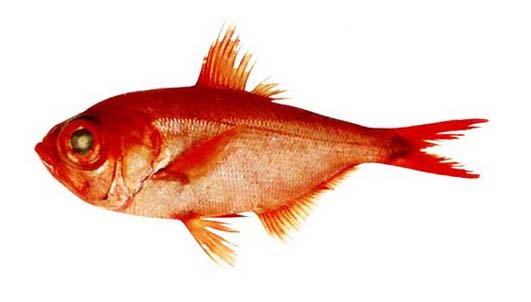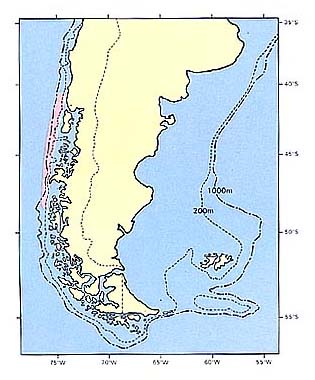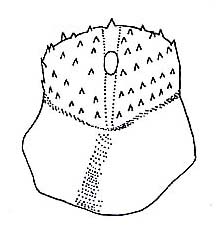キンメダイ科
- HOME
- デジタル図鑑
- パタゴニア海域の重要水族
- 硬骨魚綱 キンメダイ目
- キンメダイ科
キンメダイ科(Bericidae)

56 キンメダイ(Kinmedai)
Beryx splendens Lowe, 1833
特 徴:
背鰭4棘,13〜16軟条,臀鰭4棘,26〜29軟条,胸鰭1棘,17軟条,腹鰭1棘,11軟条,鰓耙数5〜7+1+17〜19=23〜25,鰓条骨数8,側線鱗数74〜83。頭長は体長の34.0〜36.4%,眼径は11.1〜12.7%,体高は36.4〜41.8%,吻長は6.7〜7.5%,両眼間隔は7.1〜7.6%,上顎長は18.0〜19.1%,胸鰭長は24.4〜29.1%,腹鰭長は21.1〜24.7%,第1背鰭高は19.4〜24.7%(若魚では59.3%),臀鰭高は14.6〜17.7%。体はやや延長し,かなり側扁する。頭は大きく,体長は頭長の2.7〜2.9倍,体高の2.4〜2.7倍。吻は短くて,吻長は眼径の半分より小。口は大きくて斜位。上顎後端は眼の中央部下に達する。下顎は上顎より前方に突出する。眼は非常に大きく,頭長は眼の約3倍。鼻孔は1対で,後鼻孔は前鼻孔の約2倍の大きさ。眼の前縁に強い棘がある。両顎に狭い歯帯がある。両眼間隔域は平坦で無鱗,その幅はほぼ吻長に等しい。擬鰓がある。櫛鱗が体部,峡部,前鰓蓋骨および主鰓蓋骨に分布する。各鱗は後縁部に2〜7本の棘と内側中央部に軟骨性隆起を有する。側線は単線で,鰓蓋上縁付近から尾鰭基底までほぼ直走する。第1背鰭は頑丈で,その起部は腹鰭起部上に位置し,その基底長は腹鰭長にほぼ等しい。若魚では第1背鰭鰭条は著しく伸長する。胸鰭は大きく,その先端は折りたたんだ時に側線を越える。臀鰭は中庸で,第1臀鰭起部は第1背鰭起部後端のやや後方に位置する。臀鰭(第1+第2)基底長は背鰭(第1+第2)基底長の約1.5倍。尾柄高はかなり高く,その高さは眼径にほぼ等しい。
分 布:
大西洋,西部太平洋,日本近海,オーストラリア,ニュージーランドに分布することが知られている(Woods and Sonoda, 1973)が,Bahamonde and Pequeño (1975)は本種をチリ海域で記録していないので,本報告がチリ海域への初記録と思われる。
備 考:
本種に近縁のBeryx decadactylusは広くインド,西太平洋に分布する。本種は南アメリカの大西洋側では普通に見られる(Krefft, 1976)。
(中村 泉)
Material examined:
10 from Chile (162.9-338.4 mm SL), FAKU CP 38, 125, 387 464, 484-489.
Description:
D Ⅳ, 13-16; A ?Ⅳ, 26-29; P1 Ⅰ, 17; P2 Ⅰ, 11; GR 5-7+1+17-19=23-25; BR 8; LLS 74-83. HL 34.0-36.4% of SL; ED 11.1-12.7; BD 36.4-41.8; SN 6.7-7.5; IO 7.1-7.6; UJ 18.0-19.1; CP 9.7-11.5; P1L 24.4-29.1; P2L 21.1-24.7; D1H 19.4-24.7 (young 59.3); A1 14.6-17.7.
Body elongate and fairly compressed. Head large, 2.7-2.9 times in SL, body depth 2.4-2.7 times in SL. Snout very short, shorter than half of eye diameter. Mouth large and oblique, posterior end of maxilla reaching beyond mideye level. Lower jaw anterior to upper jaw. Eye very large, about 3 times in HL. Two nostrils, posterior nostril twice larger. A stout spine on anterior part of eye. Teeth on both jaws in narrow band. Interorbital region wide and naked, its width about equal to snout length. Pseudobranchiae present. Ctenoid scales on body, isthmus, preopercle and opercle. Each scale with 2 to 7 fine spines posteriorly and a cartilaginous process at middle of inner surface. Lateral line single, running straight onto caudal fin. Dorsal fin stout, its origin above pelvic fin origin and its base. about equal to pelvic fin length. First dorsal fin ray extremely elongate in young. Pectoral fin large, its tip reaching beyond lateral line when depressed. Anal fin moderate, its origin slightly posterior to end of dorsal fin base. Anal fin base 1.5 times in dorsal fin base. Caudal peduncle fairly long, its depth about equal to eye diameter.
Distribution:
Widely distributed in the Atlantic and in hthe western Pacific, Japan, Australia and New Zealand (Woods and Sonoda, 1973). This seems to be a new record to Chile, as Bahamonde and Pequeño (1975) did not record this species in Chile.
Remarks:
The closely related species, B. decadactylus, is distributed in the Indo-West Pacific. This species is common off the Atlantic coast of South America (Krefft, 1976).
(Izumi NAKAMURA)

Distribution of Beryx splendens in Patagonia.

Lateral line scale.
- 1